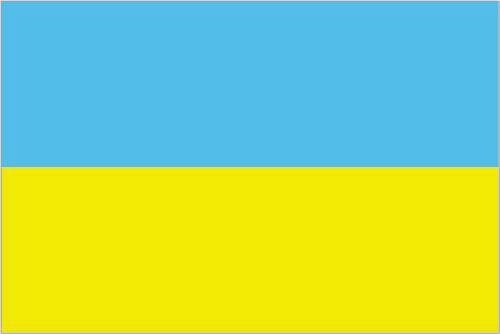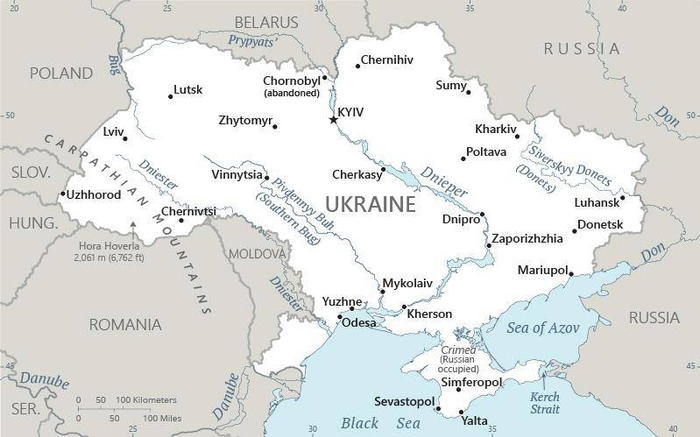113 Ukraine

Two equal horizontal bands of azure (top) and golden yellow. Although the colors date back to medieval heraldry, in modern times they are sometimes claimed to represent grain fields under a blue sky.
Flag courtesy of the CIA World Factbook

Map courtesy of the CIA World Factbook

The Uspensky Sobor (Dormition Cathedral) at the Kyiv Pechersk Lavra (Kyiv Monastery of the Caves) complex. Originally constructed between 1073 and 1078, it was further enlarged over the subsequent centuries. Destroyed by the Soviet Army in 1941, the cathedral was rebuilt between 1998 and 2000.
Photo courtesy of the CIA World Factbook
Government
According to Britannica, the government of Ukraine underwent rapid change in the early 1990s. Before its declaration of independence in 1991, Ukraine was officially called the Ukrainian Soviet Socialist Republic (S.S.R.) and was part of the Soviet Union. According to the 1937 Soviet constitution as amended in 1944, Ukraine had the right to “enter into direct relations with foreign states, to conclude agreements, and to exchange diplomatic and consular representatives with them” and to maintain its own military forces. The only real expression of these constitutional prerogatives in international affairs, however, was Ukraine’s charter membership in the United Nations (UN) and consequently in some 70 other international organizations. (The Ukrainian S.S.R. and the Belorussian S.S.R. [now Belarus] were the only two UN members that were not fully sovereign countries.) The revised Soviet constitution of 1977 further limited the prerogatives of the Ukrainian S.S.R. Within days of the failed coup against Soviet leader Mikhail Gorbachev, Ukraine proclaimed its independence on August 24, 1991, and won overwhelming popular approval for this act in a referendum on December 1, 1991. Ukraine was subsequently recognized by other governments, and many international agreements were signed, notably with neighboring countries. In addition, Ukraine, Belarus, and Russia formed the Commonwealth of Independent States, which was then joined by eight other former republics of the defunct Soviet Union.
Ukraine adopted a new constitution in 1996. Until that time, the Soviet-era constitution had remained in force, albeit with numerous adjustments.
The highest legislative unit of the Ukrainian government is the unicameral Verkhovna Rada (Supreme Council of Ukraine), which succeeded the Supreme Soviet of the Ukrainian S.S.R. Changes to electoral laws in 1997 stipulated that half of the legislative seats would be apportioned among members of the various political parties according to their relative share of the popular vote. The other half of the legislators were to be elected from single-seat constituencies by a simple majority vote. This system remained in place until 2004, when the constitution was amended to abolish the mixed legislative structure in favor of a system of proportional representation based on political party lists.
The president, elected by direct popular vote for a five-year term, is the head of state. The president acts as the commander in chief of the armed forces, oversees executive ministries, and has the power to initiate and to veto legislation, though vetoes may be overturned. The president also chairs the National Security and Defense Council and determines its composition.
The early period of Ukrainian independence was marked by a weak presidency and a strong parliament. In fact, Leonid Kravchuk, Ukraine’s first democratically elected president, almost seemed to downplay his role. After his election in 1994, Pres. Leonid Kuchma set out to redefine the structures of power in Ukraine. In 1995 the parliament agreed to the so-called “Law on Power,” which substantially enhanced the role of the executive branch of government, and in 1996 the new constitution gave the presidency considerably more power. A 2004 constitutional reform, which took effect in 2006, shifted some power away from the president to the prime minister, but in 2010 Ukraine’s Constitutional Court declared that reform unconstitutional. The strong presidential powers outlined in the 1996 constitution were thus restored. Those changes were repealed in February 2014, after months of popular protest toppled the government of Pres. Viktor Yanukovych, and the 2004 constitution was reinstated.
The head of government is the prime minister, who is appointed by the president with the consent of the legislature. The president, with the consent of the prime minister, also appoints the members of the cabinet. The cabinet, headed by the prime minister, coordinates the day-to-day administration of the government and may introduce legislation to the Supreme Council. The president has the power to dismiss the prime minister and the cabinet.
Ukraine is a unitary republic, not a federal state. The country is divided administratively into a number of provinces called oblasti; two cities, Kyiv and Sevastopol, carry the same status as an oblast. Crimea is an autonomous republic within Ukraine. In 2014 Crimea was occupied and annexed by Russia, but few countries and international organizations recognized the legality or legitimacy of the move.
The highest court in the judicial system is the Supreme Court of Ukraine. The court’s function is to supervise judicial activities. Constitutional matters are determined by the Constitutional Court.
State Aviation Administration of Ukraine
State Aviation Administration of Ukraine
Airspace
SkyVector – Google Maps – ADS-B Exchange
ICAO countries publish an Aeronautical Information Publication (AIP). This document is divided into three parts: General (GEN), En Route (ENR) and Aerodromes (AD). ENR 1.4 details the types of airspace classes they chose to adopt from classes A through G.
Ukraine AIP – requires login information
Drone Regulations
Regulations for usage of the Ukrainian airspace
Rules for usage of the Ukrainian airspace
Offender liability for violation of the rules and order of usage of the Ukrainian airspace is established by Articles 281, 282 Criminal Code of Ukraine.
Responsibility of legal entities – subjects of aviation activity for violation of the rules and order of usage of the Ukrainian airspace is established by article 127 of the Air Code of Ukraine.
Responsibility of individuals – subjects of aviation activity for flights in violation of regulatory legal acts regulating aviation activities, established by Article 111 of the Code of Ukraine on Administrative Violations.
The list of types of violations of the order of usage of the Ukrainian airspace is given in paragraph 46 of the Regulations for usage of the Ukrainian airspace.
Advanced Air Mobility (AAM) Regulations & Policies
None found by the author.
However, should you, the reader, happen to stumble across something to the contrary, please email the author at FISHE5CA@erau.edu and you may be mentioned in the ACKNOWLEDGEMENTS section of this book by way of thanks for contributing to this free eBook!
Advanced Air Mobility (AAM) News
None found by the author.
However, should you, the reader, happen to stumble across something to the contrary, please email the author at FISHE5CA@erau.edu and you may be mentioned in the ACKNOWLEDGEMENTS section of this book by way of thanks for contributing to this free eBook!
Short Essay Questions
Scenario-Based Question
You have been hired by a Drone Startup Company. Your boss has immediately assigned this job to you.
They need you to prepare a one-page memo detailing the legalities of using a drone to film in Ukraine.
They need you to mention any national laws and local ordinances.
They specifically want to know what airspace (insert pictures) you will be operating in and whether or not you need an airspace authorization.
Does it matter whether or not you are a citizen of the country?
Lastly, there is a bonus for you if, as you scroll through this chapter, you find any typos or broken links!
Short Essay Questions
- What are the drone categories?
- How is registration addressed?
- How is remote ID addressed?
- What are the model aircraft rules?
- What are the commercial drone rules?
- Are there waivers or exemptions to the rules? If so, for what?
- Would you share a link to an interactive airspace map?
- How is BVLOS addressed?
- How can you fly drones at night?
- How can you fly drones over people?
- Where do you find drone NOTAMs?
- What are the rules for drone maintenance?
- What are the rules for an SMS program?
- What are some unique rules not mentioned above?
- What are the C-UAS rules?
- What are the AAM rules?

